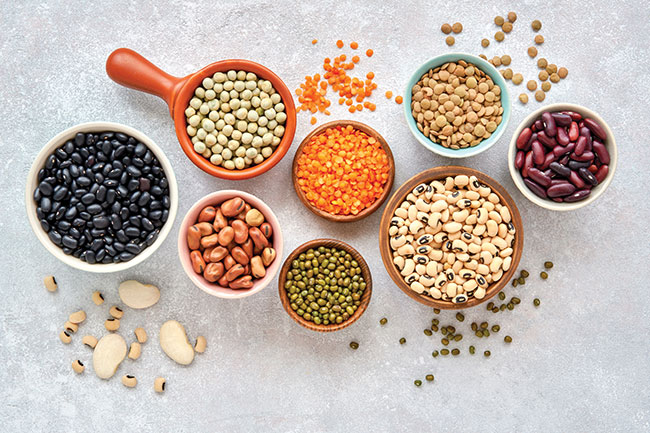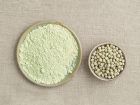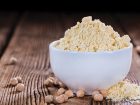
Give peas a chance
February 20, 2020
By Naomi Szeben
Alternative flours can give a boost of protein while providing a gluten-free baking solution
 Flours made from legumes and fava bean isolate can add protein, fibre for gluten-free baking and those looking for cruelty-free options. Lead image: © Veliavik / adobe stock
Flours made from legumes and fava bean isolate can add protein, fibre for gluten-free baking and those looking for cruelty-free options. Lead image: © Veliavik / adobe stock Bakers Journal had the chance to speak with Mariana Macovei, Project Leader, Ingredion Canada Ingredion Canada. We discussed the nature of functional baking, and what bakeries should consider when choosing a plant-based option for their menu.
For Ingredion, the first step begins with an in depth customer inquiry as to their expectations: Bakers looking for a boost of protein in their bakery mixes have several options available for bean or pulse-based flours. Bakers looking for a gluten-free application have more options today than they did several years ago.
There are other options also available for dairy-free formulations, for bakeries looking to break into a vegan or plant-based product. Either way, Macovei states that the process is collaborative. “From the functionality point of view, we really have to look at what the proposed products will bring to a recipe and how we would adjust the recipe to maximize functionality and also to make the product better.”
It’s about more than nutrition, according Macovei. Ultimately, taste is the main motivator in baked goods, functional or indulgent. However, there are some challenges in working with beans and dairy-alternatives. “We cannot take any of the ingredients and just replace it one-to-one.” explains Macovei. “Inevitably, we have to understand what’s the composition of the product. Whether it’s a flour, a concentrate, or an isolate we have to see what that particular ingredient brings to the application.” According to her, when it comes to baked goods, one of the most challenging applications are the gluten free applications.
“Part of the issue for gluten-free baking lies with trying to build back the structure and also to enhance the quality,” explains Macovei. Gluten-free baked goods are often notorious for poor mouthfeel or a gritty texture. “In cases of gluten-free products we did see lots of improvements on the market, but this is where the ‘post’ products can play a major role in enhancing the texture, improving the whole experience of eating.”
One particular success was Ingredion’s work with a gluten-free pita, made with chickpea flour, which also offers the advantage of offering some protein and a bit more fibre, than with standard gluten-free formulations. “For that particular application, the chickpea flour was a little bit above 10 per cent, in the recipe. So it will bring some micronutrients to it as well, because it is in the flour. Also, that particular recipe had a little bit of resistance starch; the starch will help with the digestive system.”
Macovei is aware of the criticism that gluten-free breads get, and understands where consumers are coming from. “They are looking at a gluten free formulation that tries to mimic traditional bread as closely as possible. There are recipes available where different pulse flours will replace the traditional flour, and they will bring a different texture to the table, they will bring good volume and open cell structure, in case of breads.” An added advantage to pulse flour? “It can eliminate Other protein sources like the animal protein sources, like egg whites or whey concentrate.”
A good or “traditional” loaf is measured by its height and palatability. Many gluten-free loaves are flatter, denser and known for an unpleasant flavour. Many companies use emulsifiers or fats to improve mouthfeel, but there are still challenges to making a loaf rise, taste moist and not gritty. “Decreasing, reducing and almost bringing the sandiness to zero that gluten-free formulations are associated with,” are some key touch-points for gluten-free flour baking. “Fava bean concentrate has a dual role, because it’s acting as a protein source, and also as an emulsifier, and this is one of the characteristics for fava bean protein.”
As for sugar reduction, when we try to reduce sugar — and this is traditionally across the board — not only in the bakery segment, we have to look at every application, every particular element, to make sure that we understand what sugar is doing in that case.
“When we replace sugar, we have to bring back the sweetness level, we have to bring back the volume-bulking properties. We have to bring back any caramelization or Maillard Reaction that goes into a bread application or a pastry application, for example,” states Macovei.
“It’s so very important for the whole industry, not only for bakers, to understand what a customer needs. If we understand the customers’ needs to reformulate a particular segment or application with certain solutions that will work for a couple of applications, like added protein or gluten-free, but that might not work well for other applications.”
Food science is improving options for those with food allergies and the food industry’s need to provide options for a wide range of requests. Whether your bakery wants to meet vegans’ ethical standards, or provide allergy-free options, “giving peas a chance” might provide solutions for all.
Print this page



Leave a Reply